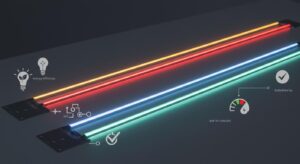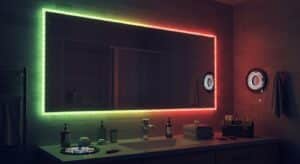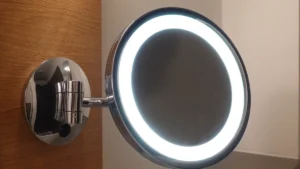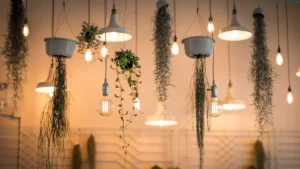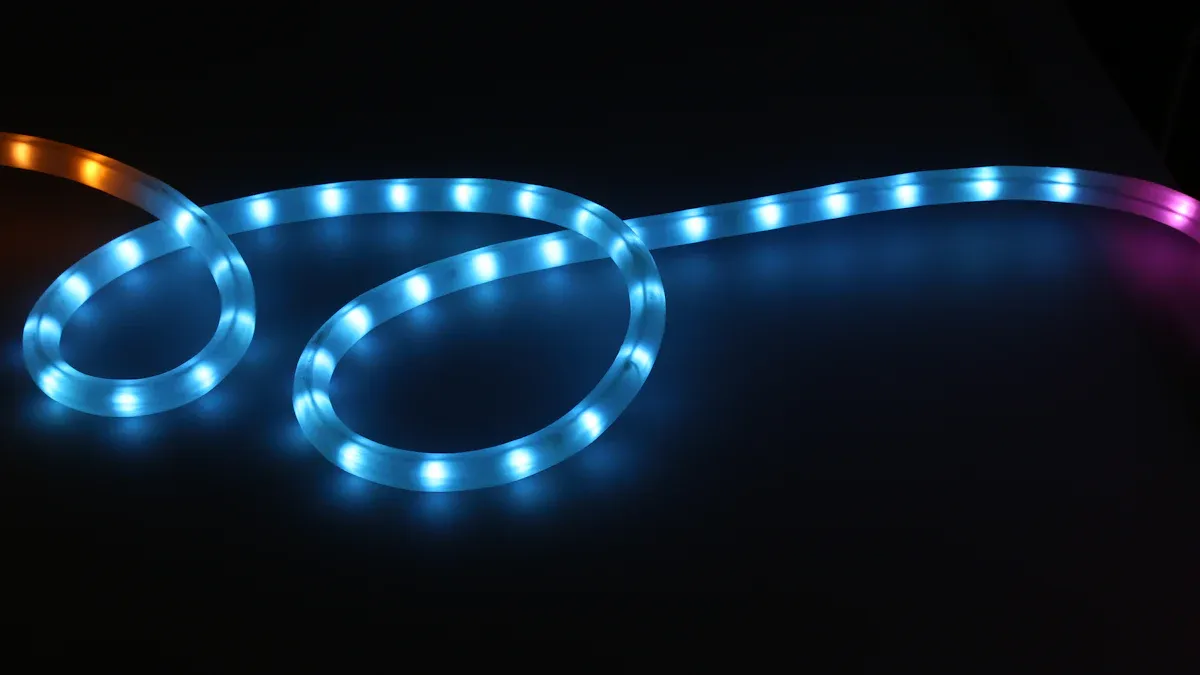
Transforming your bar shelves into a glowing centerpiece is easier than you think. LED lights are perfect for creating a stylish and functional vibe. With just a few tools and some creativity, you can light up your bars and impress your guests. Plus, LED lighting is energy-efficient and lasts for years.
Key Takeaways
Collect all tools and supplies before installing LED lights. You’ll need LED strips, sticky tape or clips, a power source, and rulers.
Think about your design to make the lighting look even. Put LED strips at the front, center, and back of shelves for a nice glow.
Use sturdy tape or clips to hold LED strips in place. Weak tape might fall off, especially if it’s damp, and make things look messy.
Tools and Materials for Installing LED Lights
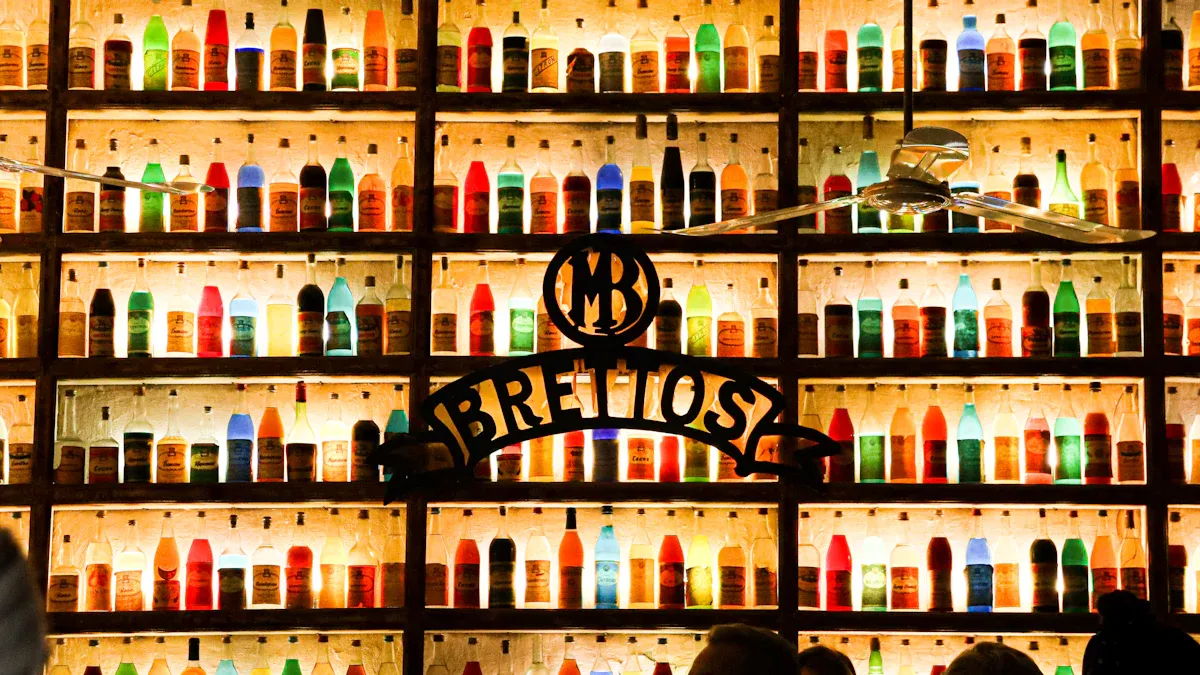
Before starting, gather all the tools and materials you need. Being prepared makes the job easier and more fun. Here’s what you’ll need:
LED light strips
LED light strips are the main part of this project. Choose strips with high lumens for brighter light. A CRI above 90 ensures colors look vivid and real. If your shelves are in a damp spot, pick strips with a good IP rating to protect them from water. For long shelves, check the maximum run length to keep the brightness even.
Specification | What It Means |
|---|---|
Lumen | Measures brightness; higher numbers mean more light. |
CRI | Over 90 gives true and bright colors. |
Ingress Protection (IP) | Shields against dust and water; great for lasting use. |
Maximum Run Length | Keeps light evenly bright across longer strips. |
Adhesive or mounting clips
Use adhesive or clips to attach the LED strips. Adhesive works best on smooth surfaces. Clips are better for rough or uneven areas. Weak adhesives might fail, so pick strong ones for a secure hold.
Power supply and connectors
A good power supply keeps the lights working well. Add 20% extra wattage to your total for safety. Look for UL or CE-certified power supplies for reliability. Waterproof ones are best near water. Use connectors to link strips or attach them to power without soldering.
Tip: Keep the power supply in a cool, open spot to avoid overheating.
Measuring tape and scissors
Measure carefully for a neat installation. Use a tape measure to find the right strip lengths for each shelf. Cut the strips along the marked lines with scissors. This step saves time and ensures a perfect fit.
Optional accessories like dimmers and remote controls
Dimmers and remotes make your lights more flexible. Dimmers let you change brightness to match the mood. Remotes help you control the lights easily without touching the power supply. Some smart dimmers even track energy use to save money.
Pro Tip: Try smart accessories that work with home automation for more control and convenience.
Step-by-Step Guide to Installing LED Lights
Measure and Plan the Layout
Plan where the LED lights will go before starting. A good layout makes your shelves look neat and work well. Follow these tips to measure and plan:
Front of the Shelves: Put LED strips on the front edges. This brightens shelves and makes items easy to see. Keep them 2-3 inches from the edge to avoid shadows.
Middle of the Shelves: Place strips in the center for even lighting. This is great for showing off glassware or collectibles.
Back of the Shelves: Add strips at the back for a soft glow. This works well if your bar already has other lights.
Corners and Bottom of the Shelves: Use thin, flexible strips for corners and undersides. This adds depth and highlights the design.
Pro Tip: Draw your layout on paper before cutting strips. This helps you see the final look and avoid mistakes.
Prepare the Surface for Installation
Clean shelves before installing LED lights. Dust, grease, or moisture can weaken adhesives and make strips fall off. Follow these steps to prep:
Use isopropyl alcohol to clean dust and dirt.
Make sure the surface is dry and at room temperature.
For rough surfaces, use mounting clips instead of adhesive.
Clean both the strip lens and shelf surface for a strong bond.
Even small amounts of grease can ruin adhesives. Take your time cleaning for better results.
Attach the LED Light Strips
Stick the LED strips onto your shelves. You can use adhesive backing, clips, or channels. Here’s a quick comparison:
Method | Description |
|---|---|
Adhesive Backing | Easy to use and works well on smooth, clean surfaces. |
Clip Mounting | Holds firmly on uneven surfaces but needs drilling. |
Channel Mounting | Protects strips from dirt and improves their look. |
Peel off the adhesive and press the strip onto the shelf. If using clips or channels, attach them first, then slide the strip in.
Tip: Don’t stretch the strips while installing. This can break the wires inside.
Connect the Power Supply Safely
Connect the power supply carefully. Safety is very important. Use a power supply that matches the LED strip voltage (12V or 24V). Follow these safety tips:
Use a Class 2 power supply that meets safety codes.
Pick UL or CE-certified supplies for reliability.
Keep Class 1 and Class 2 circuits apart to avoid hazards.
Use junction boxes to cover connections safely.
For permanent setups, use Class 2 In-Wall Rated Wire to prevent damage.
Place the power supply in a ventilated area to stop overheating. Check all connections before turning it on.
Test and Adjust the Lighting
Turn on the LED lights to test them. Look for problems and fix them. Here’s what to check:
Testing Procedure | Description |
|---|---|
Electrical Performance Testing | Make sure voltage and current match the strip needs. |
Thermal Testing | Check that strips don’t get too hot. |
Dimming Compatibility Testing | Test dimmers for smooth brightness changes without flickering. |
Ingress Protection Testing | Confirm resistance to dust and water for damp areas. |
If everything works, adjust the lights for the best look. Make sure brightness and placement create the mood you want.
Pro Tip: Use dimmers to set the brightness and match the occasion.
Tips for Getting the Best LED Lighting Effects
Picking the Right Color Temperature
The color temperature of your LED lights affects the mood. Measured in Kelvin (K), it decides if the light feels warm or cool. Use this guide to choose:
Bar Type | Best Color Temperature (K) | What It Does |
|---|---|---|
Cozy, Classic Bars | 2000K-3000K | Warm white light gives a relaxing and inviting glow. |
Modern, Stylish Bars | 5000K-6500K | Cool white light adds a sleek and lively feel. |
Multi-use Bars | 3500K-4500K | Neutral white light works for different activities. |
Outdoor Bars | Mix of warm and cool | Warm light for comfort, cool light for safety and visibility. |
Warm white is great for a calm vibe. Cool white fits modern styles. Neutral white works for all-purpose bars. Outdoor bars need both warm and cool tones for balance.
Tip: Try different color temperatures before deciding. This helps match the lighting to your bar’s style.
Setting Brightness for the Right Mood
Brightness is key to creating the right atmosphere. Too bright feels harsh, while too dim loses appeal. Think about the space and purpose when choosing brightness. Here’s a quick chart:
Area | Suggested Brightness |
|---|---|
Bedroom | 2000 – 4000 lumen |
Living Room | 1500 – 3000 lumen |
Bathroom | 3000 – 3500 lumen |
Dining Area | 470 – 800 lumen |
For bar shelves, use brightness that highlights items without being too strong. Try these ideas:
Add LED strips behind bottles for a soft glow.
Use dimmable strips to change brightness for different events.
Light specific spots with under-shelf strips for focus.
Combine recessed and strip lights for a layered look.
Pro Tip: Dimmable lights let you switch between bright and soft lighting easily.
Placing Lights for Even Glow
Where you put your LED lights is very important. Good placement avoids shadows and bright spots. Backlit shelves are a favorite for bars. This uses LED strips to light bottles from behind, making them stand out.
Use several small lights instead of a few bright ones for even lighting. For example, placing strips along the back edges of shelves creates a soft glow. Adding lights under shelves highlights the design and adds depth.
Smart placement reduces glare and makes your bar look professional.
Using Dimmers and Remotes for Control
Dimmers and remotes make your lighting more flexible. They let you adjust brightness, change colors, and control lights from afar. Look for these features:
Works with RGB, RGBW, and tunable white lights.
Connects to smart home systems for easy control.
Options like touch or motion controls for convenience.
These tools let you switch between party lighting and a calm glow. Smart dimmers also save energy by managing brightness.
Tip: Pair dimmers with remotes for quick changes during parties or gatherings.
Common Mistakes to Avoid When Installing LED Lights
Installing LED lights on shelves is fun and rewarding. But, some mistakes can ruin the results. Avoid these errors to make your bar shelves shine perfectly.
Not Measuring Correctly
Measuring correctly is key for a neat installation. Skipping this step can leave strips too short or too long. Always measure each shelf carefully. Mark where the strips will go. Use a measuring tape and check your numbers twice. This small step saves materials and prevents a messy look.
Tip: Sketch a simple plan on paper before cutting strips. It helps you see the final design and avoid mistakes.
Picking Weak Adhesive or Clips
Using weak adhesive or clips can cause problems. Strips may peel off, especially in humid areas like bars. This ruins the look and costs more to fix.
Weak adhesives fail quickly.
Replacing strips wastes time and money.
For rough surfaces, use mounting clips instead of adhesive. Clips hold better and keep your lights secure.
Overloading the Power Supply
Overloading the power supply is dangerous. It can cause overheating or even fires. This happens if parts don’t match or are installed wrong. Follow these tips to stay safe:
Keep the power supply away from flammable items.
Match the power supply voltage to your LED strips.
Buy from trusted brands to avoid overheating the LEDs.
Add 20% extra wattage to your total to pick the right power supply.
Ignoring Safety Rules
Safety is very important when installing LED lights. Ignoring it can cause accidents or damage. Exposed wires or bad connections are risky. Use junction boxes to cover connections. Keep circuits separate. Place the power supply in a ventilated spot to avoid overheating.
Small safety steps prevent big problems. Double-check all connections for safety.
By avoiding these mistakes, you’ll create a safe and beautiful LED light setup that makes your bar look amazing.
Installing LED lights on your bar shelves is a fun and easy way to upgrade your space. With the right tools and a little planning, you can create a stylish and functional setup. Why wait? Start your project today and enjoy the cozy ambiance and energy savings these lights bring!
FAQ
What’s the best way to hide LED light strips on shelves?
You can use aluminum channels or diffusers. These not only hide the strips but also create a polished, professional look.
Tip: Choose channels with frosted covers for softer lighting effects.
Can I cut LED light strips to fit my shelves?
Yes, you can! Look for the scissor icons on the strip. Cut only at these marked points to avoid damaging the lights.
How do I choose the right power supply for my LED lights?
Add up the wattage of all your strips. Then, pick a power supply with 20% more wattage to ensure safe and efficient operation.
Note: Always match the voltage (12V or 24V) of the power supply to your LED strips.
See Also
How To Set Up LED Light Bars In Signage
Using LED Strip Lighting For Your Kitchen Cabinets
Guide To Installing LED Modules In Channel Letter Signs
Steps To Properly Wire An LED Light Bar
Effective Installation Tips For RGB LED Strip Lights
